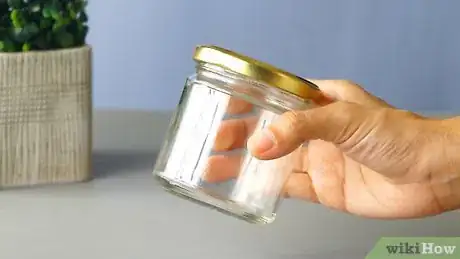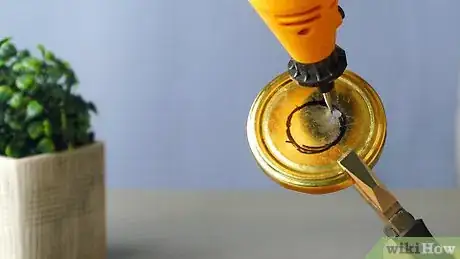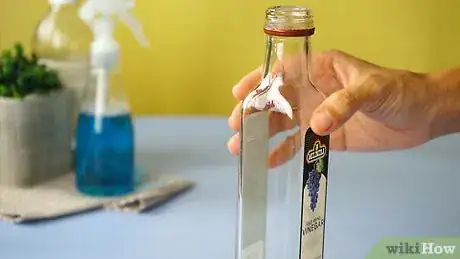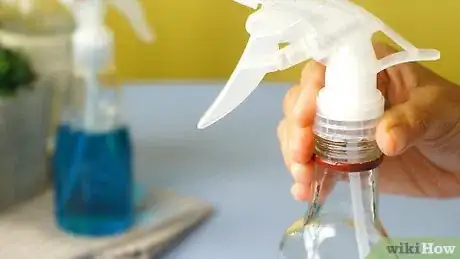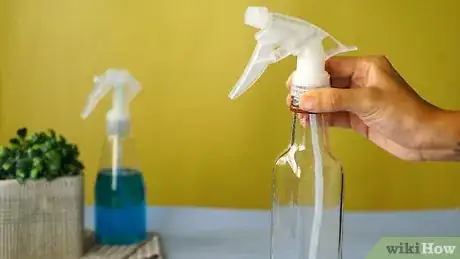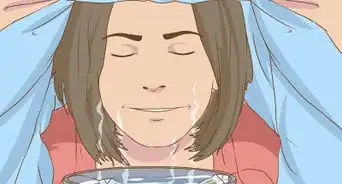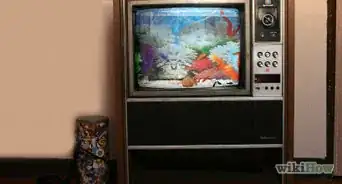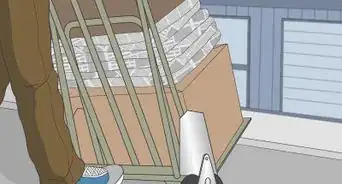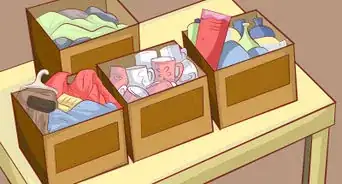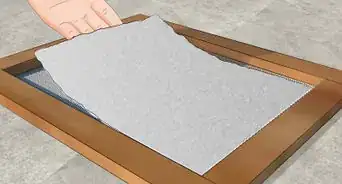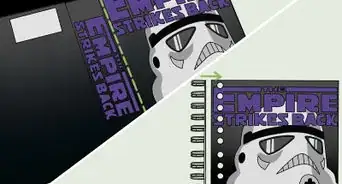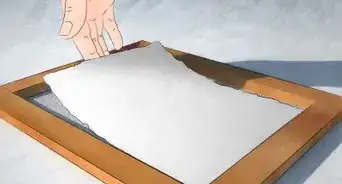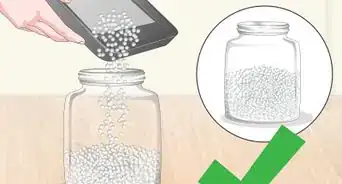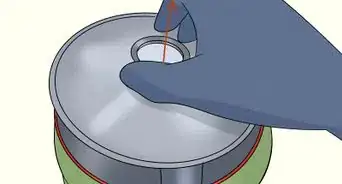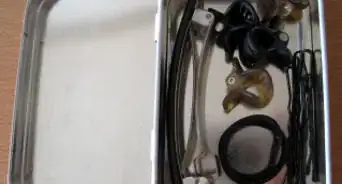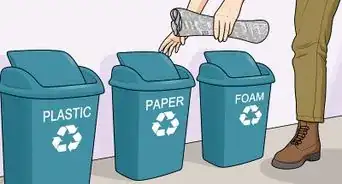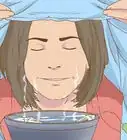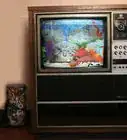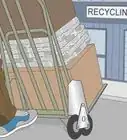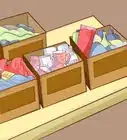This article was co-authored by wikiHow Staff. Our trained team of editors and researchers validate articles for accuracy and comprehensiveness. wikiHow's Content Management Team carefully monitors the work from our editorial staff to ensure that each article is backed by trusted research and meets our high quality standards.
The wikiHow Video Team also followed the article's instructions and verified that they work.
This article has been viewed 80,397 times.
Learn more...
Making your own spray bottle can be useful for cleaning, making perfumes and other cosmetic items, watering plants and much more. Glass spray bottles are best because, unlike plastic, they do not cause harmful chemicals to seep into the liquid inside the bottle. You might be discouraged from buying reusable glass spray bottles because of the price tag, but luckily they are easy to make yourself from bottles or jars that you already have!
Steps
Using a Glass Jar
-
1Cut off the top of a plastic spray bottle using an X-acto knife. Make sure the spray cap is unscrewed from the bottle. Then, slice the plastic in a circle about 2 cm (0.79 in) away from the mouth to remove it from the bottle.
- You don’t have to cut around the mouth in a perfect circle — just try to make the width roughly the same all the way around.[1]
-
2Select a small glass jar to repurpose. Smaller glass jars — around 15 cm (5.9 in) tall tend to work best for this project, but the size of the jar does not matter a whole lot. Just keep in mind that larger jars might be more bulky and difficult to use as a spray bottle.Advertisement
-
3Trace the outline of the bottle mouth on the middle of the jar lid. Place the mouth of the bottle top-down on the lid of the glass jar you are using — meaning that the plastic you cut should be facing up. Use a permanent marker to carefully trace the shape of the inside of the bottle mouth on the lid. You will end up with a small circle that shows you where to cut on the lid.
- The hole that you are going to make in the jar lid should be wide enough to fit the mouth of the plastic bottle through it.[2]
-
4Drill around the outlines in the lid to make a circular cut-out. Attach any general-purpose twist drill bit to your drill. Then, clamp down your lid—using a minimum of 2 clamps—so it hangs off of the side of your work surface. This way, your drill won’t contact another surface once it cuts through the metal. Next, lower the tip of the drill bit onto the metal and begin drilling at a low speed. Drill around your outline until you can remove your circular cut-out from your lid.
- Wear goggles to protect your eyes while you are drilling in case any metal pieces fly off. It only takes one tiny piece of metal to do serious damage to your eye.[3]
- The hole does not have to be a perfect, smooth cut. If the edges are jagged, that’s okay! You can use needle-nose pliers to curl any sharp pieces down. Just make sure that the plastic bottle mouth fits snugly through the hole in the lid.[4]
-
5Push the bottle mouth through the hole and attach the spray nozzle. Press the bottle mouth through the underside of the lid so that the top of the mouth (where the sprayer nozzle screws on) protrudes from the lid. Test to make sure that the sprayer attaches to the mouth without a problem.
- If the sprayer doesn’t screw all the way on, the mouth of the bottle probably isn’t pushed all the way through the lid. Go back with your drill and try to widen your circular cut-out if this is the case.
-
6Secure the bottle mouth to the lid with hot glue, if necessary. This is not necessary if your bottle mouth fits snugly against your lid. However, if your bottle mouth is loose, apply a thin layer of hot glue to the part where the lid and the bottle mouth contact each other. This should hold the bottle mouth in place.
-
7Trim the hose if necessary, then screw your completed lid onto the glass jar. Now that the spray nozzle is attached to the lid of the glass jar, put the lid on the jar. If the plastic hose of the sprayer is too long for the jar, you may need to trim it with scissors.[5]
Repurposing a Glass Bottle
-
1Choose a glass bottle with a small mouth. The size of the bottle itself can vary. The best place to start looking is your pantry! Water, vinegar, and juices are often packaged in glass bottles that have the same-sized mouth and grooves as plastic spray bottles.[6]
- Empty red wine or apple cider vinegar bottles tend to be the perfect size for this project.
-
2Find a plastic spray nozzle that screws onto the lid of your glass bottle. Many glass bottles will have small lids that work with plastic spray nozzles. You just have to test them to see which ones fit on your bottle.
- Check your local dollar store to see if they carry any cheap spray bottles that you could use the nozzles from.[7]
- Alternatively, reuse the spray nozzle from a plastic bottle you already have. Examine and test the bottles of cleaning or hair care products that you already have to see if any of those will work with your glass bottle.
-
3Remove the sticky label with olive oil. Coat the label of the bottle with olive oil and then fill the bottle with water. Place it in a sink filled with warm, soapy water and leave it to soak for 30 minutes. After 30 minutes, remove the bottle and gently peel off the label.
- Filling the bottle with liquid makes it sink and prevents it from just floating on top of the water.[8]
-
4Wash both the inside and outside of your bottle. Fill the bottle halfway with warm soapy water. Use a small bottle cleaning brush with synthetic bristles to remove any residue on the inside of the bottle. Then, use a sponge and warm soapy water to clean the oil off of the outside of the bottle.[9]
- If warm soapy water isn’t removing the oil from the surface of the bottle, mix together equal parts white vinegar and water in a separate container. Then, dab the mixture on a paper towel and use it to wipe away the oil.[10]
-
5Screw on the spray nozzle and trim the hose, if necessary. The hose attached to the spray nozzle (the part that sucks up the liquid inside) may be too long for your new bottle, so cut it with scissors if necessary. The hose may also have a small particle strainer on the end of it, but you can easily pop this off and attach it to the newly-cut end if needed.[11]
Community Q&A
-
QuestionWill cleaning the bottle get rid of all chemical that were inside it?
 T. ChinsenTop AnswererUnless the contents had warning labels on the level of toxicity, washing the bottle will clean the bottle. A rinse with a little baking soda can neutralize anything that may react.
T. ChinsenTop AnswererUnless the contents had warning labels on the level of toxicity, washing the bottle will clean the bottle. A rinse with a little baking soda can neutralize anything that may react. -
QuestionCan you make a spray bottle without the nozzle?
 Otterly BadgerificTop AnswererThe nozzle is essential for the ability to make spray; it wouldn't be a spray bottle without using a nozzle.
Otterly BadgerificTop AnswererThe nozzle is essential for the ability to make spray; it wouldn't be a spray bottle without using a nozzle.
Warnings
- You might be tempted to just reuse your old plastic spray bottles for your homemade cleaners. Avoid doing this, because most homemade essential oil cleaners will cause the plastic to release chemicals.[12]⧼thumbs_response⧽
Things You’ll Need
Repurposing a Glass Bottle
- Dish soap
- Warm water
- Olive oil
- Bottle cleaning brush
- Brush (optional)
- Glass bottle
- Spray nozzle and hose
- Scissors
Using a Glass Jar
- Glass jar with a metal lid
- Empty plastic spray bottle (with working sprayer)
- X-acto knife
- Permanent marker
- Handheld drill
- Clamps
- Protective goggles
- Hot glue (optional)
- Scissors
References
- ↑ https://crunchybetty.com/how-to-turn-a-glass-jar-into-an-eco-friendly-spray-bottle/
- ↑ https://crunchybetty.com/how-to-turn-a-glass-jar-into-an-eco-friendly-spray-bottle/
- ↑ https://www.familyhandyman.com/tools/drills/tips-for-drilling-holes-in-metal/view-all/
- ↑ https://crunchybetty.com/how-to-turn-a-glass-jar-into-an-eco-friendly-spray-bottle/
- ↑ https://crunchybetty.com/how-to-turn-a-glass-jar-into-an-eco-friendly-spray-bottle/
- ↑ https://bodyunburdened.com/diy-glass-spray-bottle/
- ↑ https://brendid.com/diy-glass-spray-bottle-for-cleaning/
- ↑ https://www.mom4real.com/make-glass-spray-bottle/
- ↑ https://www.mom4real.com/make-glass-spray-bottle/

